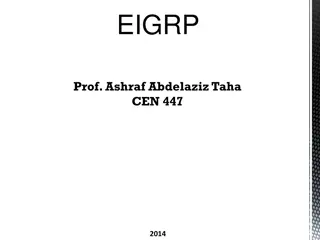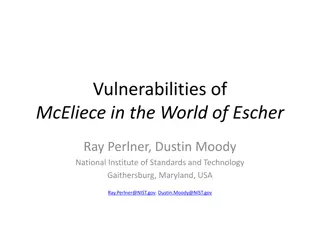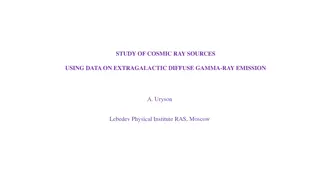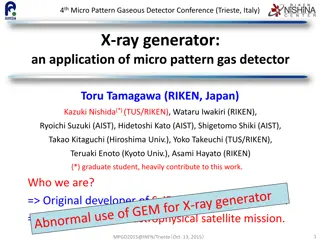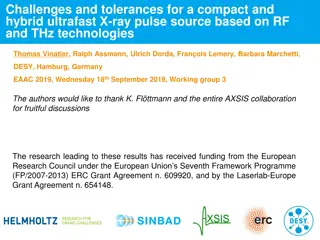Overview of BIKE Key Exchange Protocol by Ray Perlner
The BIKE (Bit-Flipping Key Exchange) protocol, presented by Ray Perlner, offers variants based on MDPC codes like McEliece and Niederreiter with a focus on quasi-cyclic structures. These non-algebraic codes show promise for key reduction, targeting IND-CPA security. The protocol features competitive performance compared to lattice-based schemes but with potentially easier attack complexity analysis. BIKE-1 prioritizes KeyGen speed, BIKE-2 optimizes PK and ciphertext size, while BIKE-3 introduces a patented LWE-like key exchange method with a modified syndrome decoder. Decoding MDPC codes involves finding low-weight errors, crucial for secure communication.
Download Presentation

Please find below an Image/Link to download the presentation.
The content on the website is provided AS IS for your information and personal use only. It may not be sold, licensed, or shared on other websites without obtaining consent from the author.If you encounter any issues during the download, it is possible that the publisher has removed the file from their server.
You are allowed to download the files provided on this website for personal or commercial use, subject to the condition that they are used lawfully. All files are the property of their respective owners.
The content on the website is provided AS IS for your information and personal use only. It may not be sold, licensed, or shared on other websites without obtaining consent from the author.
E N D
Presentation Transcript
BIKE (Bit-Flipping Key Exchange) Presented by Ray Perlner
High Level Summary Variants of McEliece/ Neiderreiter based on Quasi-Cyclic MDPC codes Non-algebraic codes like MDPC codes look good for key reduction with quasi cyclic structure (unlike algebraic codes e.g. those used in DAGS and BigQuake) Performance is competitive with lattice-based schemes, but attack complexity seems easier to analyze. Has somewhat high dec. failure rate (< 10-7); targeting IND-CPA. Three versions BIKE-1: McEliece KEM: Optimized for speed of KeyGen BIKE-2: Niederreiter KEM: Optimized for PK, ciphertext size. BIKE-3: patented LWE-like Ouroboros key exchange. Uses modified noisy syndrome decoder. Slightly different security assumption (probably.)
Some Coding Theory Generator matrix (Systematic form) ? ? ? = [??| ?] Parity Check matrix (Systematic form) ? (? ?) Syndrome: ? = ?(?? + ?)?=?(??) Mapping s to minimal weight e is sometimes easy but NP hard in general. McEliece Encryption: ?? + ? is ciphertext, ? is plaintext. Niederreiter Encryption: ? is ciphertext, ? is plaintext. Note: Both McEliece and Niederreiter KEMs for BIKE use Hash(?) as shared secret. ? = ???? ?] Defining feature: ???= 0 Codewords ? may either be defined as n-bit vectors that can be expressed as ? = ?? for ?-bit ? Solutions to ???= 0
MDPC (Moderate Density Parity Check) Codes (special case where n = 2k) Secret sparse parity check matrix: ? = ?0?1 Public parity check Random Row mixing (BIKE-1): ????1= ?? = ??0??1 Systematic form (BIKE-2): ????2= ?1 1? = 1?0? ?1 Public Generator Matrix (Systematic Form) ????= (?|(?1 1?0)?) ?= ????1???? ?= ????2???? ?= 0. NOTE: ????? So all are the same code.
Decoding MDPC codes (The Bit-Flip Algorithm) Want to find low weight e such that ???= ?
Decoding MDPC codes with noisy syndrome (used in BIKE-3) Want to find low weight e, e such that ???+ ? ?= ?
Quasi-Cyclic structure Use ? = 2?, where ? is prime and ?? 1 is (? 1) times a primitive polynomial mod 2. Represent ? ? = ? ? (? ?) blocks as polynomials in the ring GF2 ? /?? 1. Now block multiplication commutes. And blocks only require ? bit representation. They look like this: ? ? ? ? ? ? ? ? ? ? ? ? ? ? ? ? ? ? ? ? ? ? ? ? ? ? ? ? ? ? ? ? ? ? ? ?
BIKE 1-3 Summary Table (Switching to their notation for variable names.) ? and ? are random polynomials in GF2[x]/(?? 1) ?0and ?1are polynomials in the same ring with hamming weights summing to ?. e, when present has Hamming weight ?/2. If you do out the math ? = ?0 0+ ?1 1(for BIKE-1,2) and ? = ?0 0+ ?1 1+ ? for (BIKE-3)
BIKE Parameters Polynomials are over ring GF2[x]/(?? 1) ? = 2? is the number of bits in the error vector (?0,?1) ? is the Hamming weight of the error vector. ? is the row weight of the MDPC code ( 0, 1)
Performance (Note: Jacob s numbers look similar, although consistently larger by a factor of ~2.) BIKE-1 BIKE-2 BIKE-3
BIKE-2 Batch Key Generation Assumes polynomial inversion is more expensive than polynomial multiplication Generate polynomials ?,?,? Compute ??? 1= (? ? ? ) 1 To get e.g. ? 1 compute ? 1=??? 1 ? ? .
Known attacks: Information Set Decoding Basic idea Guess k-bits of low weight codeword/ error vector and use linear algebra to find the rest. Find error vector: Permute columns of ? resulting in ? = ?? = (?|?). Hope first ? bits of ?? are zero. If so, can multiply first ? bits of (?? + ?)? by ? 1 to recover m Asymptotic complexity: ? ? Find MDPC private key: Permute columns of ???? resulting in ? = ???? = (?|?). Hope first ? bits of a row of ??are (1, 0, , 0). If so, the row of ?? is the top row of ? 1? Asymptotic complexity: ? ? Complications Fancier versions of ISD: Stern s algorithm, MMT, BJMM etc. Same asymptotic complexity as ?/? and ?/? go to zero. (Note for MDPC: ? ? ? target rows in parity check matrix: Improves key recovery complexity to 1 Ring structure plus Decoding One Out of Many (DOOM) improves error finding complexity to 1 Grover s algorithm gives near full square root speedup ? ? ? ? ?) ?. ? ? ? ? ?. ? ? ? ?
Known attacks: Reaction Attacks Guo, Johannson, Stankovsky [GJS 2016] show how to recover private key from statistical analysis of decryption failures. This attack does not affect the claimed security of BIKE, since it is recommended for ephemeral-ephemeral use only, and only claims IND-CPA security.
Choice of r Polynomials are over ring GF2[x]/(?? 1) Recall that ? is chosen so that ?? 1 Why? Possible reasons: It s easy to tell whether a polynomial is invertible (only requires odd hamming weight strictly less than ?) Might be worried about folding attacks like [Hauteville, Tillich 2015] on LRPC codes. ? 1 is irreducible mod 2.
Security Proof Submission gives an attempted security proof Basic assumptions: QC - MDPC codes in systematic form look random. Syndromes from random QC codes and low weight error vectors look random. Won t go into detail, but I think there are errors in the proof Claims BIKE-3 and BIKE-1 have same assumptions (I think it BIKE-1 should have same assumptions as BIKE-2). A little less clear about distinction between search and decision than I d like Since GF2[x]/(?? 1) factors as GF2[x]/(? 1) GF2[x]/(?? 1+ + 1), parity of syndromes/ codes is often predictable. (Pointed out on forum.) Nonetheless, for what it s worth, I think something like the attempted proof can be correctly stated/ proved.
Similar submissions Straight up knock off QC-MDPC-KEM Pretty much the same problem HQC (If BIKE is NTRU, this is RingLWE) Similar problem; probably harder to analyze LEDApkc/LEDAkem Basically the same scheme, but Rank metric LAKE/Locker, Ouroboros-R Basically the same scheme, but Euclidean metric NTRUxxx
Advantages and limitations Advantages All known IND-CPA attacks are well-understood information set decoding type attacks. ISD has been known for 45 years and improvements have left asymptotic complexity the same. Compares favorably with lattice attacks (stability) and Rank-Metric attacks (newness) Relatively small key sizes (10,000 to 65,000 bits) Reasonably fast for all operations. Except for BIKE2 keygen without batching, operations look like they take less than a millisecond on a good processor for 128 bit security. Limitations High Decryption failure rate Does not provide IND-CCA security Security proof could use improvement/clarification Key/Message sizes are slightly larger than some (ring/ cyclic) lattice and rank schemes. Vague possibility there might be something to exploit in ring structure.
Advantages and limitations Basically same as QC-MDPC/BIKE Advantages: Pretty small key size (not quite as small as Rank or Lattice) All known CPA attacks are well understood ISD type attacks, relying on algorithms that haven t gotten much better against parameters in this range since 1962. Disadvantages Needs ring structure to get a reasonable key size Decryption failures/ CCA attacks Different from QC-MDPC/BIKE Doesn t suffer from maliciously chosen ciphertext attacks like BIKE Attacker needs 240 instead of 213 plaintexts for message recovery Fixing this (if needed) would only require superficial changes to BIKE Misuse resilience Has more structure than QC-MDPC/BIKE Not clear if this can be exploited by attacks, but also has no clear benefit. Older than QC-MDPC/BIKE The insecure versions are definitely older. I think the secure version is slightly older as well.










